Economic Benefits
The Montezuma project has provided a reliable
24/7/365 beneficial reuse option for Bay Area dredging projects for 15 years.
As a pre-approved and environmentally friendly sediment option, use of the Montezuma site has accelerated permitting for dredging projects, contributing to the sustainability of the multi-billion dollar economic engine that Bay Area Ports provide for the region and the nation.
Site Design and Ecological Benefits
Hover over the red circles to learn more about the ecological benefits

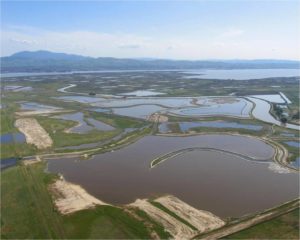
Photo credit: Aerial View of Montezuma Wetlands Project Under Construction, Montezuma Wetlands, LLC
Fish
By restoring the tidal marsh and slough habitat on site, the project aims to provide ecological benefits for many fish, including delta smelt and Chinook salmon.
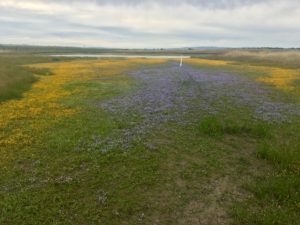
Photo credit: Vernal Pool Bloom at Montezuma, Cassie Pinnell, Vollmar Natural Lands Consulting
Rare Plants
The outboard levee of the Montezuma site supports a suite of rare plants, including Mason’s lilaeopsis and Delta tule pea. Rare plants inside the upland preserve at Montezuma include fragrant fritillary, dwarf downingia, alkali milk-vetch, and Bogg’s Lake hedge hyssop.
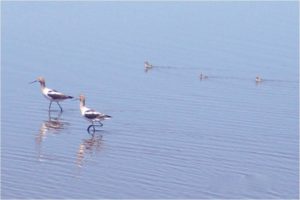
Photo credit: Shorebirds at Montezuma, Montezuma Wetlands, LLC.
Shorebirds
The restored marsh habitat at Montezuma provides important foraging and resting habitat for many species of shorebirds and waterfowl.
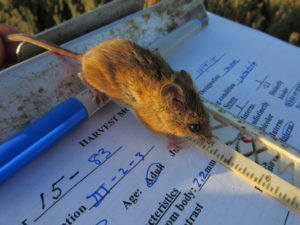
Photo Credit: Mouse Being Measured at Montezuma, Joe Didonato, Wildlife Consulting & Photography
Salt Marsh Harvest Mouse (Reithrodontomys Raviventris Halicoetes)
This endangered mouse lives in the marsh vegetation, such as pickleweed, and moves to higher ground during flooding. The Montezuma site supports this mouse throughout large areas of the project site, and is working to improve and expand its habitat by creating more high marsh and transition zone.

Photo Credit: Salt Marsh Harvest Mouse Climbing on Pickleweed, Joe Didonato, Wildlife Consulting & Photography
Upland Transition Zone
The wetland-upland transition zone (‘T-zone’) at Montezuma provides habitat for marsh species, such as the salt marsh harvest mouse, during high tide events, allowing them to move to drier ground as the water levels rise.
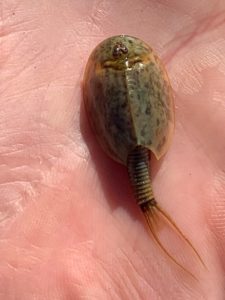
Photo credit: Tadpole Shrimp at Montezuma, Maddy Dills, Vollmar Natural Lands Consulting
Fairy Shrimp and Tadpole Shrimp
The Montezuma uplands support over 6 acres of both preserved and created vernal pool habitat. These pools support many rare, threatened, and endangered species, including vernal pool fairy shrimp (Branchinecta lynchi), Conservancy fairy shrimp (Branchinecta conservatio), and vernal pool tadpole shrimp (Lepidurus packardi), as well as many rare and endemic vernal pool plant species.
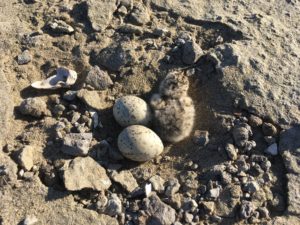
Photo credit: Least Tern Chick and Eggs at Montezuma, Anne Wallace, EcoBridges
California Least Tern (Sterna Antillarum Browni)
This endangered bird started nesting in the sand and shell flats at Montezuma in 2006. Since then, the project has constructed two habitat areas (totaling 2.5 acres) and works to support tern nesting throughout its new habitat.
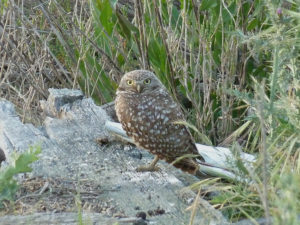
Photo credit: Western Burrowing Owl. Hamilton Wetlands, Novato, California. Jules Evens. April 15, 2011.
Western Burrowing Owl (Athene Cunicularia Hypugaea)
The upland portions of the site have supported both nesting pairs and wintering individuals. The project also constructed artificial habitat at two locations on site to expand habitat.
The Montezuma technical team developed site restoration designs that mimic historical wetland topography and hydrology. Designs have been reviewed by an interagency Technical Review Team that has provided project oversight for 15 years.
The site’s unique physical location where fresh and saltwater meet in the SF Bay Delta once made the site one of the richest historically, and the Montezuma team developed plans to restore it to its key role in the nurturing of iconic California species like young salmon and smelt.
It’s extremely high ecological value as a restored wetlands site was recognized by permitting and regulatory agencies as soon as the project was announced. Later, detailed studies and analyses led the US Army Corps of Engineers (2011) to rank Montezuma at the top of all of the potential beneficial reuse habitat restoration projects in the region.